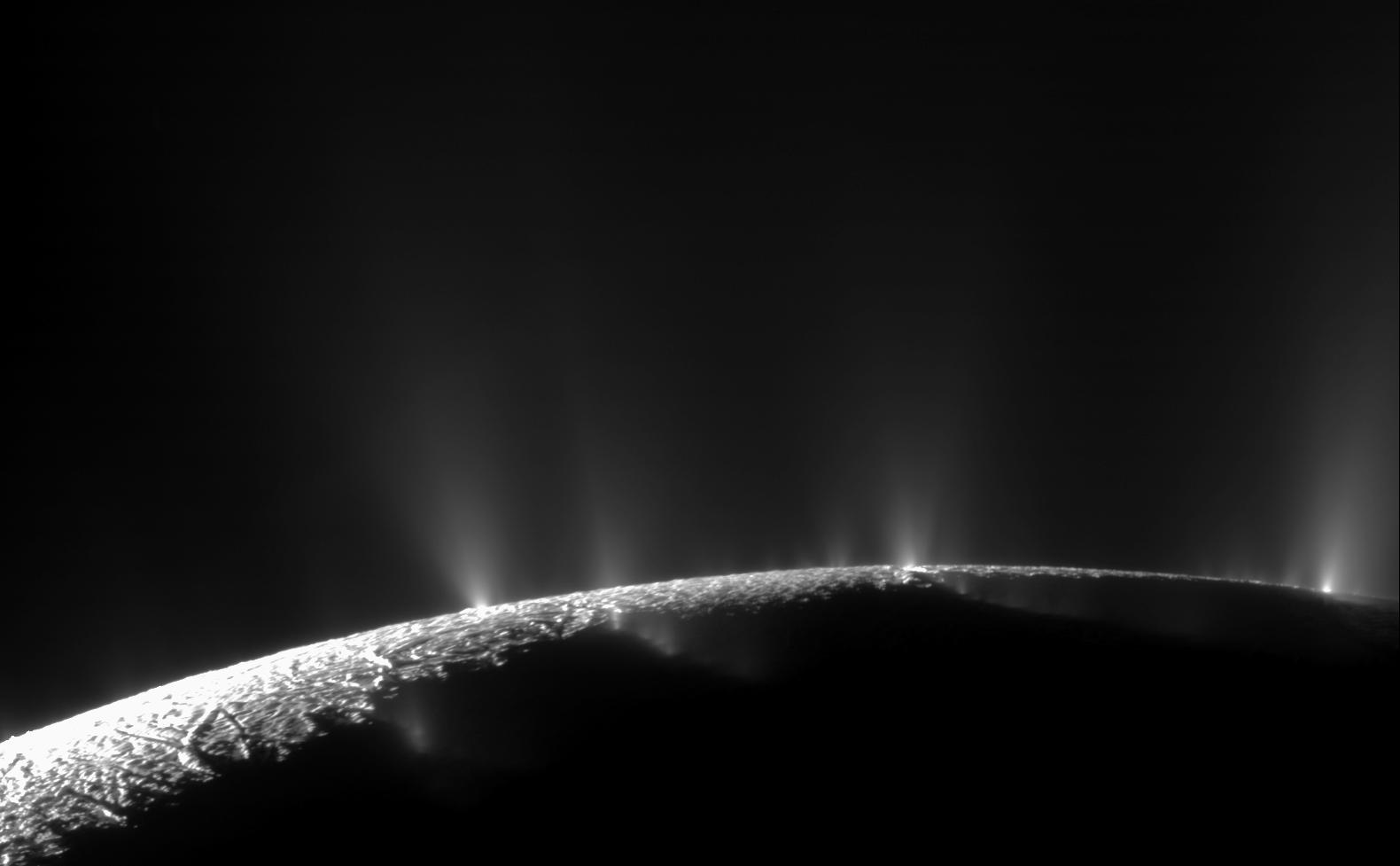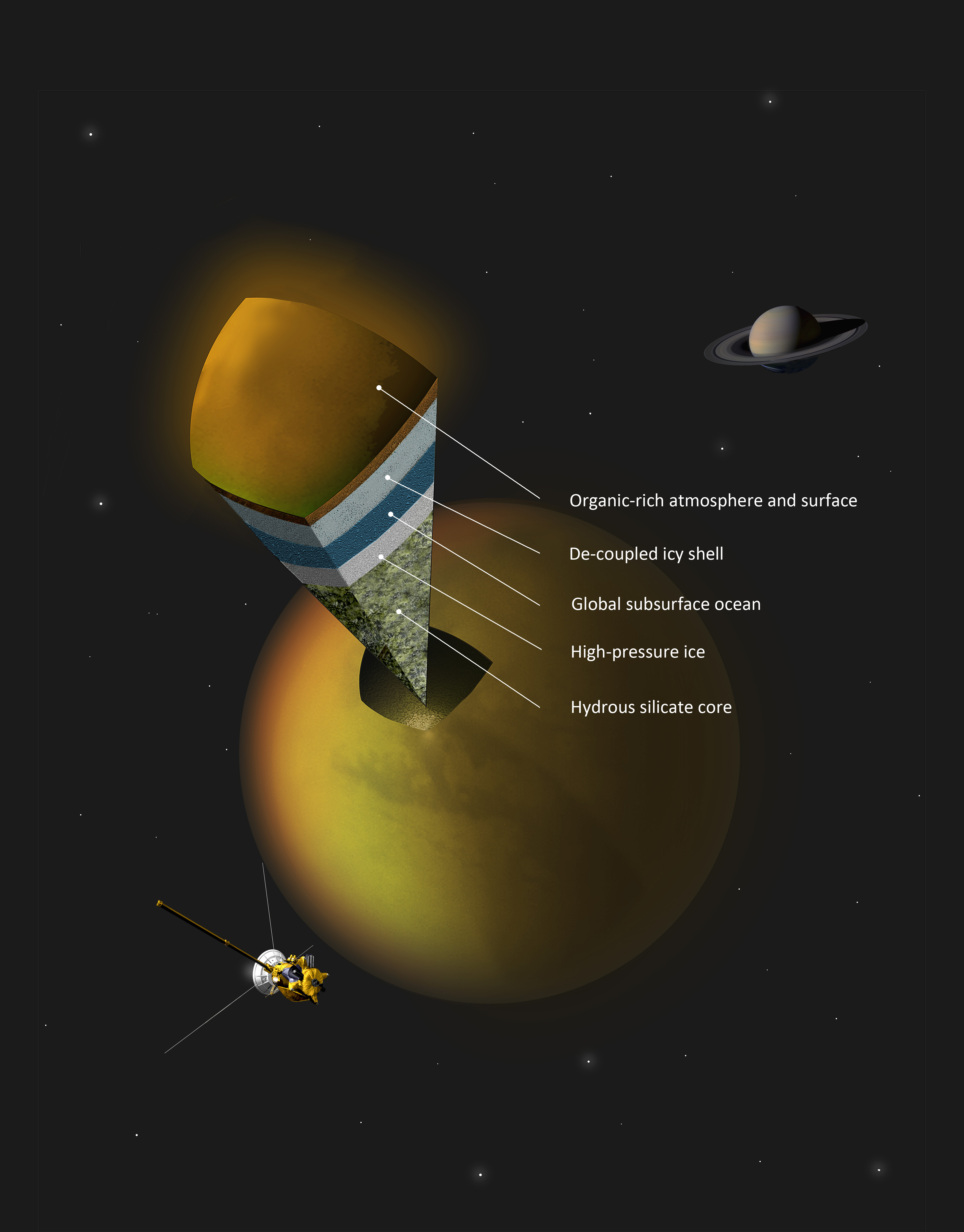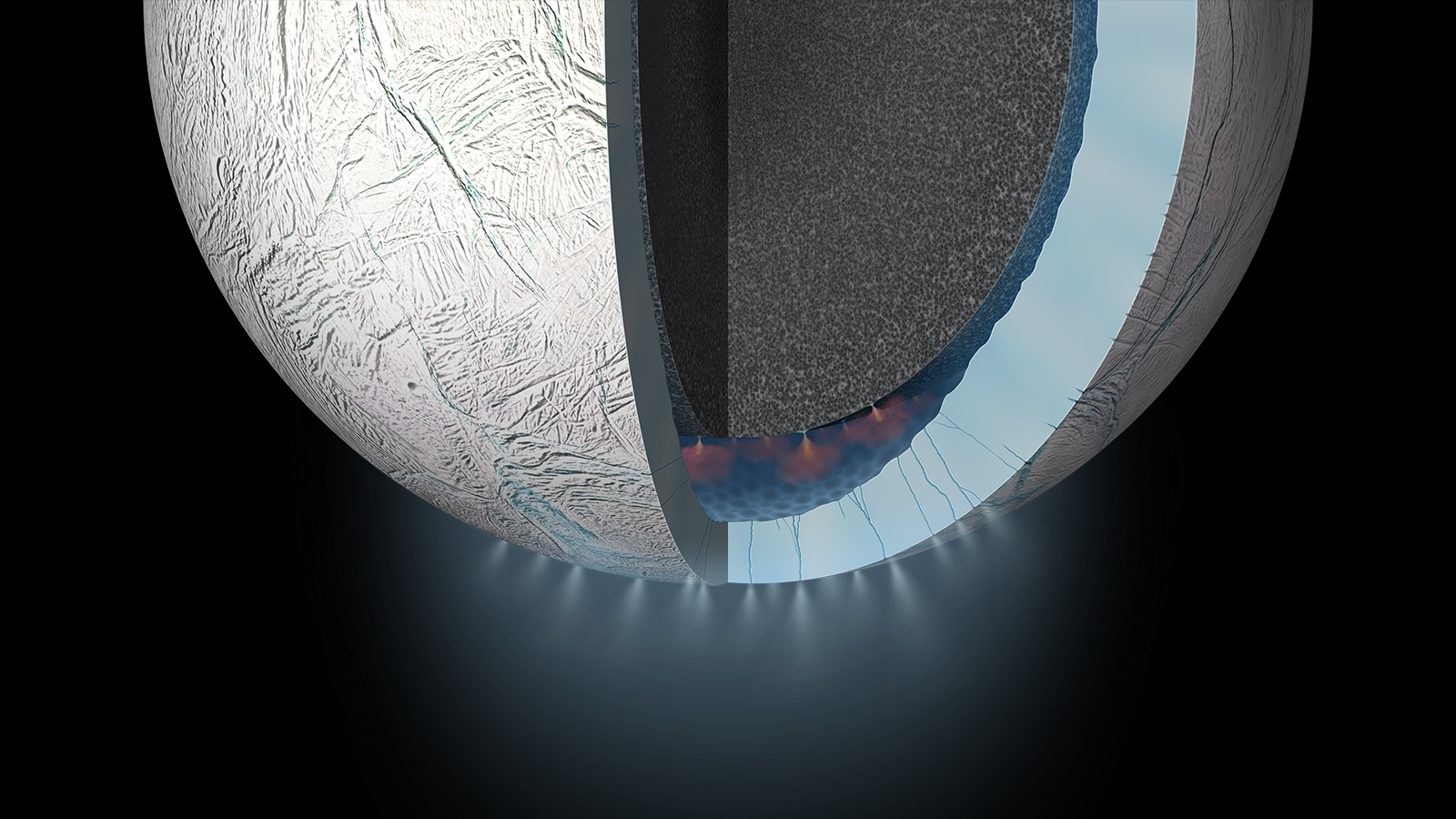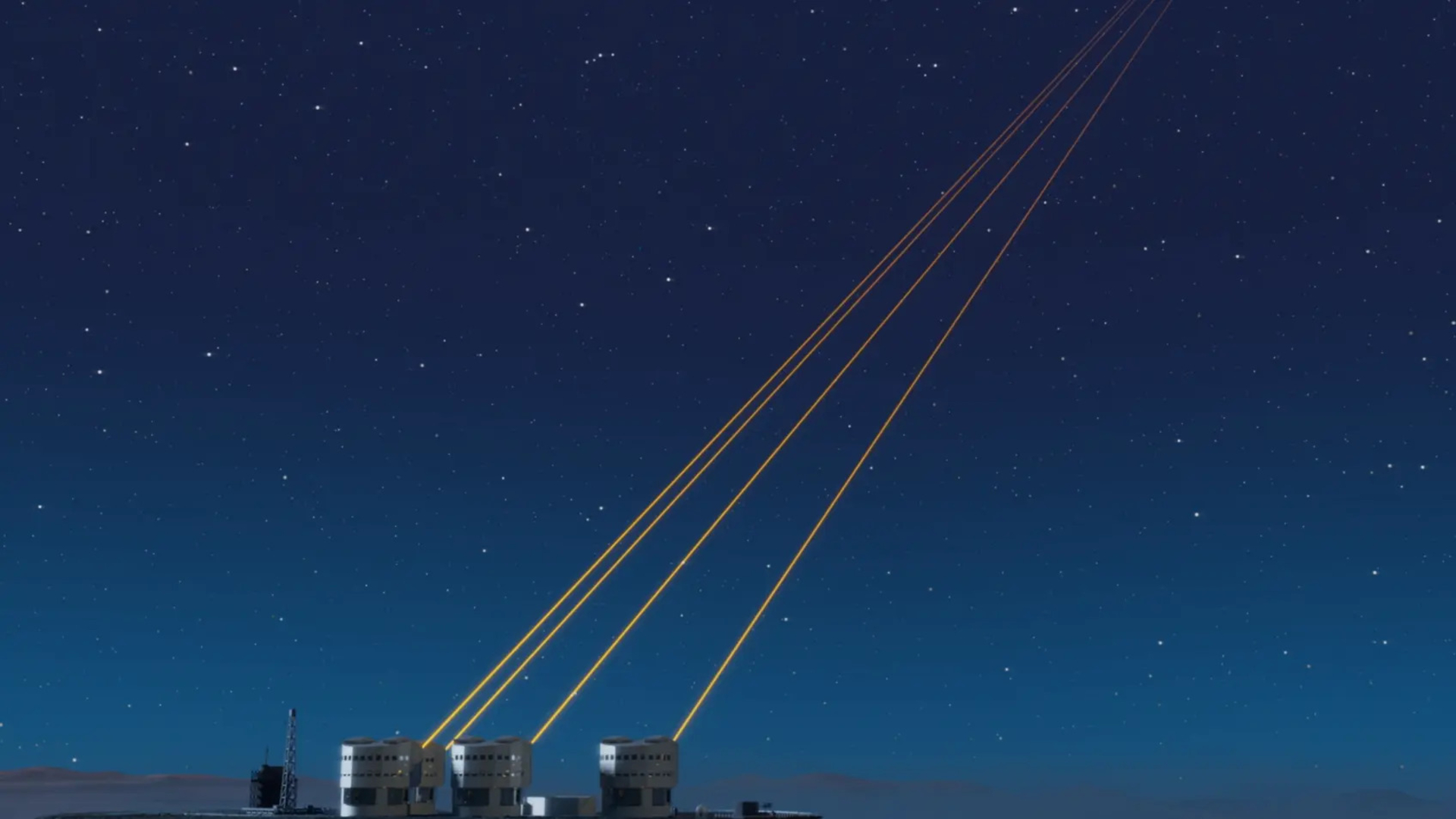Life in the Saturn System? Cassini Has Shown It's Possible
The complex choreography of Saturn's numerous moons displays beautiful physics, but only a few of the worlds may be friendly to life.
Oceans of liquid water, deep beneath the icy crusts of three of Saturn's natural satellites, may satisfy the conditions needed for "life as we know it," scientists say. The small, bright-white Enceladus and Dione, and the giant, orange, haze-enshrouded Titan each probably contain such subsurface seas. But the unique structure and contents of each ocean represent a different possible solution to the life equation.
The Cassini-Huygens mission — a collaboration of NASA, the European Space Agency and the Italian Space Agency — has been a prolific pioneer of Saturn's moons. When the mission launched in 1997, 18 moons were known to orbit the planet, and 13 more were suspected. But the number of confirmed moons now stands at 53, with another nine marked as "conditional." Cassini's data revealed seven entirely unknown moons that are not observable from Earth. [The Rings and Moons of Saturn in Pictures]
This elaborate system of moons forms a complex clockwork of gravitational resonances; they perturb one another's orbits and constantly sculpt Saturn's rings. And the massive planet gravitationally disrupts the moons, warming some of them to the point of possibly swaddling life beneath their surfaces.
The first hints that something wonderful might be going on beneath the surface of the small moon Enceladus came during the 1981 flyby mission of NASA's Voyager 2 spacecraft. Enceladus appeared remarkably bright and unusually smooth, with comparatively few craters. This 314-mile-wide (505 kilometers) moon turned out to be the whitest object in the solar system.
In 2005, Cassini's magnetometer readings of Enceladus raised researchers' eyebrows: The moon's magnetic signature looked more like that of a comet than that of a typical spherical satellite. The field lines seemed to bend around Enceladus' southern pole. On a pass where Enceladus was seen against the black background of space, Cassini's cameras caught plumes of water emanating from that polar region.
Several Cassini flybys confirmed that the area was about 180 degrees Fahrenheit (100 degrees Celsius) warmer than the rest of the moon's surface. The heat source was aligned with four prominent "tiger stripe" features. These turned out to be fissures — cracks in the icy crust through which geysers shoot water into space at about 800 mph (about 1,300 km/h).
Breaking space news, the latest updates on rocket launches, skywatching events and more!
Cassini sailed within 31 miles (50 km) of Enceladus' south pole on March 12, 2008. During that flyby, the probe sampled the plumes, and found that they were made of water laced with ammonia, methane and carbon dioxide. More flybys were planned. By April 2014, it was clear that some of the geyser particles were salty, flavored with potassium and sodium, very similar to Earthly sea spray. Hydrogen gas was detected in the jets, as were silicate crystals, which could only have been formed in boiling water, scientists said. [Photos: Enceladus, Saturn's Cold, Bright Moon]
This evidence, taken together, suggests the presence of a salty ocean of liquid water under the ice, in contact with a hot, rocky seafloor through which mineral-laden hot water flows. It is easy to imagine hydrothermal vents there, very similar to the "black smokers" and "white smokers" found on the bottom of Earth's oceans, where they form oases for communities of life.
Enceladus seems to be begging us to return with instruments capable of detecting amino acids, fatty acids and long-chain carbon molecules — and perhaps even imaging equipment to photograph any possible microorganisms themselves.
Titan, which is 10 times wider than Enceladus, is also a world of liquids. But the fluids flowing on Titan's surface are hydrocarbons, not water. At Titan's surface temperature, water is rock-hard. But methane, ethane and propane slosh around in all three states: solid, liquid and gaseous. The surface of this moon is nearly impossible to see from space at visual wavelengths; thick, orange smog pervades the place. This hazy atmosphere is rich with organic compounds.
Fortunately, Cassini can see in infrared and radar wavelengths. And the Cassini orbiter carried a lander called Huygens, which touched down on Titan's surface in January 2005. Huygens carried cameras down through the atmosphere. And, upon soft-landing on the shore of a hydrocarbon lake, it sent close-ups of rounded pebbles, which were probably made of water. The landforms on Titan are eerily familiar; they look a lot like coastlines and river lands on Earth.
Titan, too, must be warm inside. This moon changes shape as it orbits Saturn once every 16 days. Cassini measured Titan's tidal bulging, finding the surface rising and falling on the order of 30 feet (9 meters). If Titan were completely solid, those tides would be at least 10 times less pronounced, scientists have said.
But the floor of Titan's subsurface ocean may be compacted and frozen, not warm, scientists have said. This could prevent warm liquid water from receiving the complex mix of minerals necessary for life to arise, at least from below. Therefore, it's critical to know if the organic-rich surface of Titan can "communicate" with the subsurface seas.
One great mystery about Titan is how so much methane can be present at its surface. Methane breaks down quickly, so something must be replenishing it. If there are deep cracks, or cryovolcanic vents, through which ammonia from a salty underground ocean may rise, sunlight would break down the molecules, thus liberating lots of methane. That same pathway could let surface material and atmospheric organic material seep or slide down to the waters beneath. In that case, life may be possible within Titan's interior ocean, even if its floor is frozen. [Amazing Photos: Titan, Saturn's Largest Moon]
Like Enceladus and Titan, the Saturnian moons Dione and Tethys are subject to the warping and twisting effects of Saturn's tidal gravity. And both of these worlds show bright, relatively smooth and roughly circular surface patches where ponds of liquid water appear to have frozen across craters. They would make nice skating rinks. These events likely happened relatively recently on geologic time scales.
Dione is similar to Enceladus but, at 700 miles (1,100 km) in diameter, is about two times larger. Dione's icy crust is much thicker than that of Enceladus, boasting a substantial 60 miles (100 km) of crystallized water. But a recent study based on Cassini's gravity measurements suggests that a tremendous quantity of liquid water sloshes beneath that shell.
The floor of Dione's subsurface ocean is probably the rocky core of the moon itself, according to the study. A future submarine probe may find many sources of heat and mineral nutrients to sustain life, if biology ever began there — or was seeded from afar. Dione's waters likely have been liquid through most of the moon's history, adding the vital element of time for biology to evolve and differentiate, researchers have said.
Such "snow-globe worlds" — bodies with cold crystal exteriors housing warm liquid oceans full of particles cascading and mixing — are not unique to Saturn.
The dwarf planet Pluto may enclose such an ocean. Pluto and its largest moon Charon, which is about half as wide as the dwarf planet itself, can be considered a binary system. Their mutual attraction may heat up their interiors, and parts of Pluto seem to have been resurfaced in the recent past, scientists have said.
Giant Jupiter exerts massive tidal forces on the four large moons first noted by Galileo Galilei four centuries ago. The innermost of these moons, Io, almost seems to be turning inside out. More than 400 active sulfur volcanoes blast this moon's guts into space. Its core of molten iron singes the surface from below. Of the worlds in our solar system, Io may bear the closest resemblance to classical notions of hell. All of its water long since lost, it's the driest object in the solar system.
There are no water oceans on Io. But each of its three siblings — Europa, Ganymede and Callisto — encloses a sea beneath its surface.
Europa, which is slightly smaller than Earth's moon, holds a thin oxygen atmosphere. This world sports the smoothest surface in the solar system, with very few impact craters, implying that it's being repaved with water ice from inside, scientists have said. Astronomers using NASA's Hubble Space Telescope have spotted hints of water-vapor plumes emanating from Europa that may be similar to the "cryogeysers" of Enceladus.
Saturn's ocean-harboring moons get most of the press, but the ringed planet's many dry satellites are fascinating in their own right. Each Saturnian moon is a unique jewel in the majestic planet's necklace.
Some of these moons, like Mimas, look like the results of ancient, catastrophic collisions. Shady Phoebe, with its inky-black surface, pours matter out into space. It tints the rings and stains one hemisphere of Iapetus, the "next moon in" toward Saturn, with dark reddish shading. Sparky Hyperion is lightweight and spongy — almost like a giant piece of volcanic pumice — and electrically active. A few moons apparently are captured asteroids, visitors from deep space that strayed too close. And Cassini has spotted clumpy cocoons within the rings where tiny future moons may be growing. Together, the many moons of Saturn form an enthralling exhibit of nature's creativity.
For a deeper look into all that Cassini has found in its 13 years in the Saturn system, watch the 73-minute documentary "Kingdom of Saturn — Cassini's Epic Quest," available at Amazon XiveTV.
The author, @DavidSkyBrody, is the writer and director of "Kingdom of Saturn — Cassini's Epic Quest," a documentary look back at the mission, available at Amazon XiveTV. Dave Brody was formerly executive producer at Purch, the parent company of Space.com and Live Science.
Follow this author @DavidSkyBrody. Follow us @Spacedotcom, Facebook and Google+. Originally published on Space.com.

Dave Brody has been a writer and Executive Producer at SPACE.com since January 2000. He created and hosted space science video for Starry Night astronomy software, Orion Telescopes and SPACE.com TV. A career space documentarian and journalist, Brody was the Supervising Producer of the long running Inside Space news magazine television program on SYFY. Follow Dave on Twitter @DavidSkyBrody.




